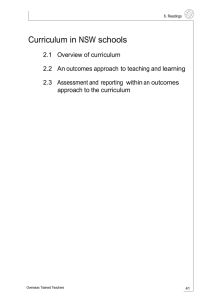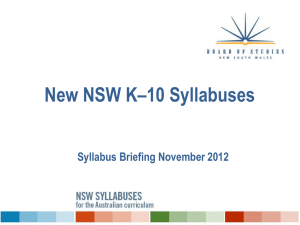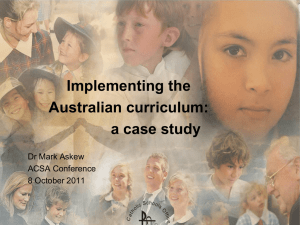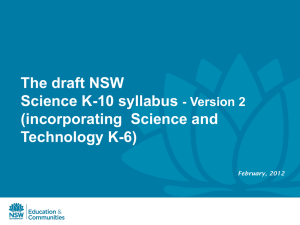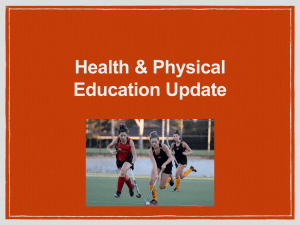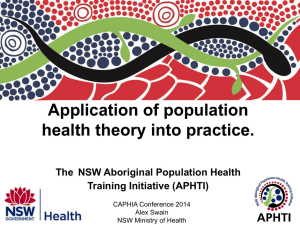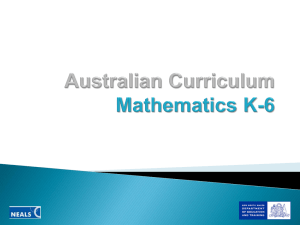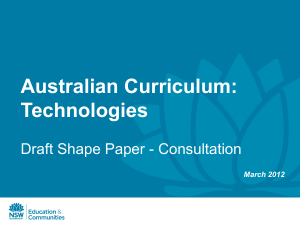Update on the Australian Curriculum
advertisement
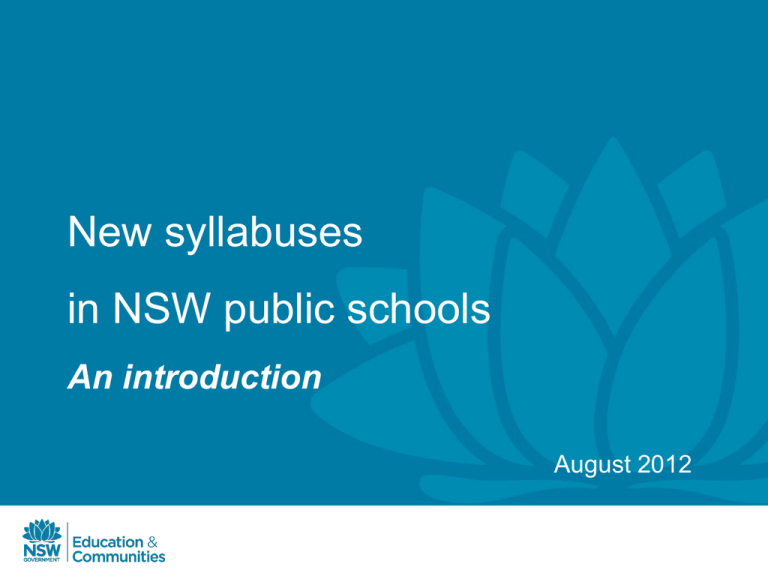
New syllabuses in NSW public schools An introduction August 2012 Key questions • Why have a new curriculum in NSW? • What will the new syllabuses look like? • How will teachers and schools be supported? • Where to from here? Activity 1 What do you know? What do you need to know? Why have a new curriculum in NSW? Why? • Up-to-date K-10 curriculum for English, mathematics, science and history • Opportunity to develop syllabuses that: – emphasise a continuum of learning – are consistent and current – incorporate cross-curriculum areas – encourage new approaches to learning • Alignment of NSW content with the Australian Curriculum Advantages for NSW • National resource sharing for quality and efficiency • A learning entitlement for all Australian students regardless of what school they attend or where it is located • Continuity for the 80 000 students and many teachers who move interstate each year What will the new syllabuses look like? The draft NSW K-10 syllabuses • The Board of Studies NSW has developed draft K-10 syllabuses for English, mathematics, science and history. • NSW school teachers will only need to teach in accordance with the new K-10 syllabus documents developed for NSW. • The Board advises all schools to continue to use the existing NSW K-12 syllabuses for 2012 and 2013. Implementation timeline 2012 2013 2014 K-6 2016 Implement English Mathematics Optional Implement Science and Technology Optional Implement History English 7-10 2015 Optional Support Familiarise materials and plan developed Implement Mathematics Years 7, 9 Science History Source: Board of Studies NSW Years 7, 8, 9, 10 What will stay the same as current NSW syllabuses? • Syllabus structure: Rationale Aims Objectives Outcomes Content Stage Statements • Stage-based organisation • Life Skills outcomes and content for Years 7-10 What will be different from current NSW syllabuses? • Some Learning Area-specific changes in content and organisation • Availability of an interactive online version • More detailed information is available in the companion presentations found on CLIC’s Australian Curriculum website. Learning across the curriculum Learning across the curriculum: • is embedded in the descriptions of content as appropriate • addresses issues, perspectives and policies that will assist students to achieve broad learning outcomes • takes account of the general capabilities and cross-curriculum priorities in the Australian Curriculum. Learning across the Curriculum Click to activate [AHC] Aboriginal and Torres Strait Islander Histories and Cultures [A] Asia and Australia’s relationship with Asia [SE] Sustainability and Environment [CCT] Critical and creative thinking [PSC] Personal and social competence [EU] Ethical Understanding [ICT] Information and communication technologies [IU] Intercultural Understanding [L] Literacy [N] Numeracy [DD] Difference and diversity [CC] Civics and citizenship [WE] Work and enterprise Learning across the curriculum– example Learning across Cross-curriculum the curriculum areas are areas are embedded in the embedded in the content and content and indicated in square indicated in square brackets brackets Interactive online format The new draft syllabuses are available in an interactive format organised either by: or K – 10 Draft Syllabuses What will be different for each Syllabus? • Information about each NSW draft syllabus is available in a PowerPoint presentation on the CLIC website • Each presentation Outlines the key features of the draft syllabus Provides details for both K–6 and 7–10 Can be used for curriculum team discussions What is new in English K-10? ‣ K-6 • Objectives and outcomes derive from the current 7-10 syllabus; intended as a means of linking the K-6 and 7-10 components of the syllabus • Stronger focus on: – viewing, representing and visual literacy – multimodal texts – comprehension strategies (Stages 2-3) – the study of literature – students creating own literary texts (Stages 2-3) • New focus on: – appreciation of the English language – text requirements – texts from different cultures, including Aboriginal and Torres Strait Islander and Asian texts – Aboriginal and Torres Strait Islander cultural concepts – supporting students for whom English is an additional dialect. What is new in English K-10? ‣ 7-10 • Subtle but important changes in objectives and outcomes • More explicit focus on: – grammar – complex forms of punctuation – comprehension strategies. • New focus on: – – – – – – – consolidation of handwriting skills in Stage 4 conventions for citing and referencing spelling and word origins appreciation of the English language Asian texts Aboriginal and Torres Strait Islander cultural concepts English as an Additional Dialect (EAD) students. • For more information see the separate English presentation What is new in Mathematics K-10? • K-6 – Movement of Stage 4 content into Stage 3 – Changes to Working Mathematically • 7-10 – Some Stage 5 content in Stage 4 – Changes to Working Mathematically • For more information see the separate Mathematics presentation What is new in Science and Technology K-6 and Science 7-10? • Science and Technology K-6 – more content – the strand Material World is new – includes foundations of chemistry and explores properties and uses of materials – emphasis on teaching and learning through processes of Working Scientifically and Working Technologically • Science 7-10 – simpler structure, with previous syllabus’ Prescribed Focus Areas now embedded in content – the skills strand, Working Scientifically, to be taught within each unit of work • For more information see the separate Science presentation What is new in History K-10? • K-6 – An emphasis on teaching historical inquiry and skills – The use of specified topics and content • 7-10 – Overview and depth studies approach – Increased flexibility of content delivery in Stage 5 • For more information see the separate History presentation Activity 2 Exploring the syllabuses •What features of the new syllabuses support quality teaching in each learning area? • How will you need to modify your teaching and learning programs? •What support would you most value? How will teachers and schools be supported? Support for schools • Initial syllabus support materials will be provided by the Board of Studies as part of the syllabus release. • The Department of Education and Communities will support syllabus implementation in public schools with professional learning together with teaching and learning resources that provide: – leadership support for principals – subject/stage support for curriculum leaders and classroom teachers. Roles in curriculum change WHOLE SCHOOL Roles in curriculum change STATE OFFICE REGION SCHOOL STATE REGIONOFFICE •Provides Leads develops support resources a whole-school for schools including: •including: professional action plan for learning professional • learning, modules school leadership updating teaching • and guides, development learning templates programs, and • teaching samples assisting and collaboration learning • resources teaching between schools. and etc.learning • implements resources the syllabuses • action planning resources • collaboration and communication tools. How can schools make a start? • Begin planning for implementation of the new syllabuses – Include preparation for implementation in school plans. – Collaborate with colleagues in your own and other schools through learning areas, cross-curriculum areas and stages of learning. • Watch for the latest news on these websites: – NSW Curriculum and Learning Innovation Centre – Board of Studies NSW Activity 3 – Reflection What have you learnt? What more do you need to know? Where to from here? Senior secondary curriculum • ACARA has developed draft senior secondary Australian Curriculum in the four learning areas of English, mathematics, science and history. For more information, see the Australian Curriculum development page of the NSW CLIC website. • Until further notice NSW teachers are to continue teaching current NSW syllabuses for senior secondary courses. Australian Curriculum development: Phase 2 • Information on curriculum development and timelines can be found on the ACARA website for – Geography – Languages – The Arts • The NSW Board of Studies will incorporate the Australian Curriculum in these areas when developing the NSW syllabuses. Australian Curriculum development: Phase 3 • See the ACARA website for information on other learning areas including – Health and Physical Education – Technologies (including information and communication technology and design and technology) – Business/Economics – Civics and Citizenship • ACARA has published draft Shape Papers in Health and Physical Education and Technologies. More information can be found on the development page of NSW CLIC’s website. Need more information? Resources • CLIC’s Australian Curriculum website • NSW Board of Studies website
